As the Oden traveled westward, we knew our our days on the ice were dwindling. We had many miles to cover to reach the ice edge of McMurdo Sound and the Oden was contracted to complete the channel icebreaking work so that the N.B. Palmer and supply ships could reach McMurdo Station. Yesterday, we spent all day cruising in the open water of the Ross Sea Polynea, hoping there would be some appropriate ice for the scheduled 24 hour ice station, possibly our last. It was a gray, dull day until after dinner, when the skies cleared just enough to let the sun's rays shine through the clouds. And we started seeing ice again, from small floes to towering icebergs. It was a beautiful night, and it was just a hint of the magic that was to come.
 The sunlight breaks through the clouds for a few magical hours.
The sunlight breaks through the clouds for a few magical hours.
 The sky at midnight was a stunning mix of sunlight and clouds.
The sky at midnight was a stunning mix of sunlight and clouds.
We spent this morning still in transit, hoping to reach an area on the "fast ice" where the Oden could safely moor for an ice station. The "fast ice" is the ice that is attached or "held fast" to the continent's edge, not the free floating pack ice and ice floes we have been working on. Co-chief Scientist Dr. Rebecca Dickhut, science coordinator Axel Meiton, and Captain Mattias Peterson went out with pilot Sven in the helicopter to scout for possible locations. They returned with good news - they thought they had found the perfect site for an ice station, as long as the ice was strong and solid enough to tie the Oden too. This cannot be fully determined until the crew goes onto the ice and drills, or cores, into it.
We could see the edge of the solid sheet of fast ice which looked very different than the large ice floes we had seen before. The fast ice had a clean-cut edge, similar to a wood or cement pier a boat would normally tie to. The ice floes usually had sloping edges, more like a sloping beach, often with smaller pieces of ice breaking off and floating around. At an ice floe, the Oden would usually have to bump into the side of it to break off the soft, thin ice then "park" in the area of thicker ice it had exposed. With the fast ice, the Oden just pulled up next to it - we could see about 1.5 meters of snow covered ice above the water's surface, and at least 3 meters of ice below the water.
 The Oden moored to the edge of the continent's fast ice - as she looks from the helicopter.
The Oden moored to the edge of the continent's fast ice - as she looks from the helicopter.
With the Oden securely moored, Blake and Brent chose the study site for the other scientists, and it was decided we would do our sea ice team work after dinner. Several of us took a long walk out to the "Mini-CTD" site, where the helicopter had transported the mini-CTD (conductivity, temperature, depth) device, which would be lowered by a winch down through a hole in the ice and report back data to a computer up on the ice.
 Jeremy Lucke looks on as the mini CTD is lowered down into the water below the ice.
Jeremy Lucke looks on as the mini CTD is lowered down into the water below the ice.
It was amazing to be on this vast field of snow covered ice, as far as you could see in three directions was ice, and the fourth direction was the water with the Oden. We were far enough away from the ship that we heard nothing at all but the occasional squawks of penguins off in the distance. The fast ice is very different than the pack ice floes because it is not loose and moving with the wind, waves, and currents, and so, it does not have the ridges, hills, crevasses, and other topography caused when the ice floes bump and smash together, then refreeze in different formations. The fast ice is mainly large flat ice sheets of uniform thickness.
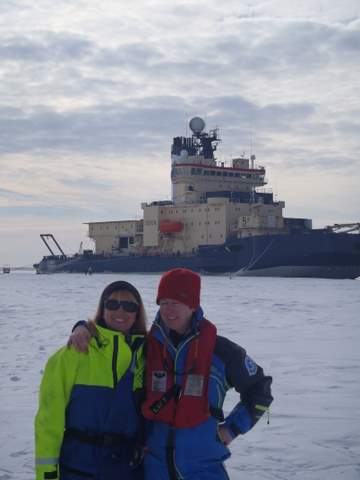 Anne Marie Wotkyns and Caroline Gennser, Oden's teachers, out on the ice.
Anne Marie Wotkyns and Caroline Gennser, Oden's teachers, out on the ice.
After dinner, Blake and David completed a transect of ice thickness measurements, leaving me to observe the Emporer penguins which had come close to the ship. This was the most Emperors we had seen in one place, and they seemed very unconcerned to have us near them.
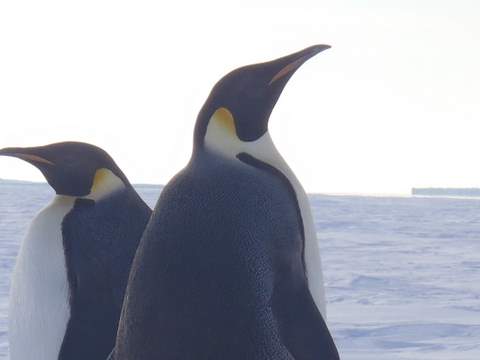 Emperor penguins are tall, slow moving, and appear so regal as they cautiously watch us.
Emperor penguins are tall, slow moving, and appear so regal as they cautiously watch us.
Emperor Penguins are the largest penguins. They can be over 3 feet tall and weigh about 70-80 pounds.They spend their lives on the sea ice, including laying 1 egg the male carries on his feet. They eat fish, squid, and krill, and can dive for 20 minutes to depths over 1000 feet. There were also several seals nearby, including one that seemed very interested in the crew's soccer ball (football in Swedish.)
 This Crabeater seal was very interested in the crew's soccer ball.
This Crabeater seal was very interested in the crew's soccer ball.
I helped Blake and David drill some holes to measure the ice thickness, with several Emperor and Adelie penguins watching us the entire time.Even the work felt like play today.
 Anne Marie Wotkyns uses a hand powered auger to drill through the fast ice to measure its thickness.
Anne Marie Wotkyns uses a hand powered auger to drill through the fast ice to measure its thickness.
As we were walking back to the ship, we encountered a funny sight - a group of Adelies traveling in a line in one direction, with a pair of larger Emperor penguins in a line to cross their path, just like cars at an intersection. Who would give way? The Adelies backed down and let the Emperors pass by first.
 Two Emperor penguins and three Adelie penguins crossing paths as they tobaggan across the snow.
Two Emperor penguins and three Adelie penguins crossing paths as they tobaggan across the snow.
The scientists and ship's crew all gathered on the ice for glogg, which is a Swedish hot mulled cider - very tasty. As we were all there, about 20 feet from the ice edge, someone yelled, "Whale!" and there, right at the ice edge, was a minke whale. We watched in amazement as his back surfaced high out of the water, then slowly submerged into a dive. No one got a picture of that, but later, from the Oden's bow, I saw several more minke whales and got a few pictures.
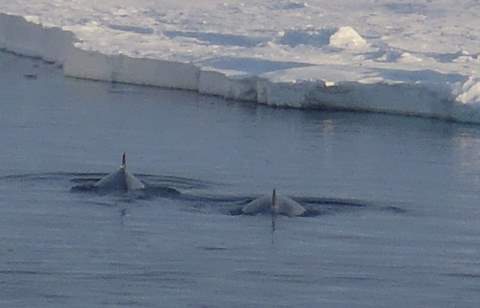 Minke whales surface in front of the Oden, near the edge of the fast ice.
Minke whales surface in front of the Oden, near the edge of the fast ice.
Minke whales are small baleen whales, about 30 feet long, and they feed on krill and small fish. I thought maybe they were feeding near and under the ice because the krill were under the ice, feeding on the algae that grows there?
And then, to finish a perfect day, Captain Mattias suggested we fly the flags again! We tied them to the aft railing so everyone on the ice could see them.
 The classroom and community group flags fly off the aft deck railing of the Oden.
The classroom and community group flags fly off the aft deck railing of the Oden.
 The flags flap in the light breeze.
The flags flap in the light breeze.
 More flags flying on the Oden's back deck.
More flags flying on the Oden's back deck.
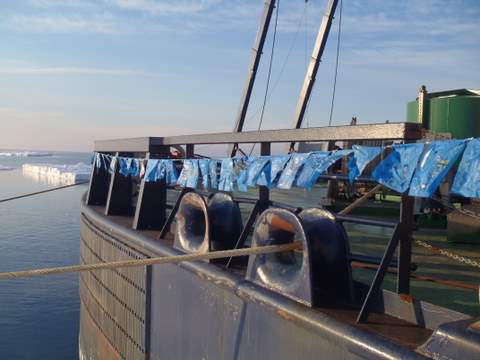 The flags Anne Marie brought with her flying from the Oden's railing.
The flags Anne Marie brought with her flying from the Oden's railing.
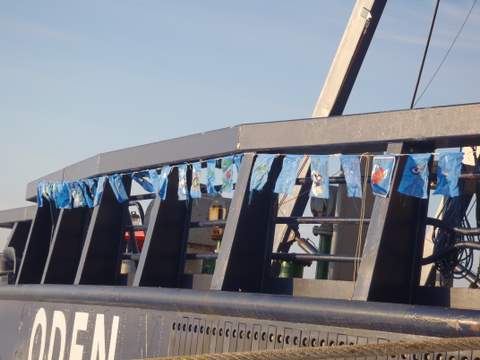 Decorated flags tied to the Oden's aft deck railing.
Decorated flags tied to the Oden's aft deck railing.
We all called this the "Magical Day" because it truly was amazing - blue skies, shallow snow which made walking easy, warm weather, more animals than we had ever seen in one place, easy work because we were mostly done with our tasks, good friends, and a location that was truly indescribable!
 Anne Marie Wotkyns near the edge of the fast ice on the Ross Sea.
Anne Marie Wotkyns near the edge of the fast ice on the Ross Sea.
Lesson Learned: Everyone needs a "Magical Day" once in a while!

